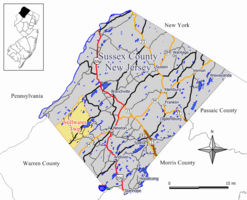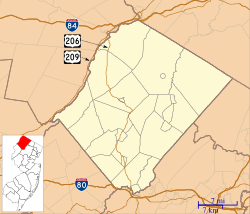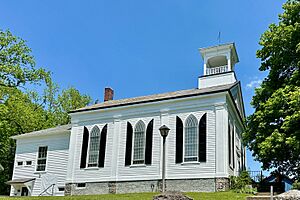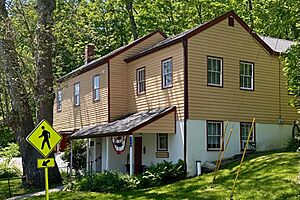Stillwater Township, New Jersey facts for kids
Quick facts for kids
Stillwater Township, New Jersey
|
||
|---|---|---|
|
Township
|
||

Casper and Abraham Shafer Grist Mill Complex
|
||
|
||

Location of Stillwater Township in Sussex County highlighted in yellow (right). Inset map: Location of Sussex County in New Jersey highlighted in black (left).
|
||

Census Bureau map of Stillwater Township
|
||
| Country | ||
| State | ||
| County | ||
| Incorporated | December 27, 1824 | |
| Government | ||
| • Type | Township | |
| • Body | Township Committee | |
| Area | ||
| • Total | 28.25 sq mi (73.17 km2) | |
| • Land | 26.92 sq mi (69.73 km2) | |
| • Water | 1.33 sq mi (3.43 km2) 4.69% | |
| Area rank | 96th of 565 in state 8th of 24 in county |
|
| Elevation | 718 ft (219 m) | |
| Population
(2020)
|
||
| • Total | 4,004 | |
| • Estimate
(2023)
|
4,063 | |
| • Rank | 413th of 565 in state 12th of 24 in county |
|
| • Density | 148.7/sq mi (57.4/km2) | |
| • Density rank | 519th of 565 in state 20th of 24 in county |
|
| Time zone | UTC−05:00 (Eastern (EST)) | |
| • Summer (DST) | UTC−04:00 (Eastern (EDT)) | |
| ZIP Code |
07875
|
|
| Area code | 973 | |
| FIPS code | 34-70890 | |
| GNIS ID | 882262 | |
| Website | ||
Stillwater Township is a township located in Sussex County, in the U.S. state of New Jersey. Situated in the Kittatinny Valley, Stillwater is a rural farming community with a long history of dairy farming. As of the 2020 United States census, the township's population was 4,004, a decrease of 95 (−2.3%) from the 2010 census count of 4,099, which in turn reflected a decrease of 168 (−3.9%) from the 4,267 counted in the 2000 census.
Stillwater was settled in the eighteenth century by Palatine German immigrants who entered through the port of Philadelphia. In 1741, Casper Shafer, John George Wintermute (Windemuth), and their father-in-law Johan Peter Bernhardt settled along the Paulins Kill. For the next 50 years, the village of Stillwater was essentially German, centered on a union church shared by Lutheran and German Reformed (Calvinist) congregations. The German population assimilated by the early nineteenth century, but evidence of their settlement remains in the architecture of the grist mills, lime kilns, and stone houses located throughout the valley. Stillwater was incorporated as a township by an act of the New Jersey Legislature on December 27, 1824, from portions of Hardwick Township when Sussex County was divided in half by the legislature a few weeks earlier to create Warren County. Portions of the township were taken to form Fredon Township on February 24, 1904.
In 2008, New Jersey Monthly magazine ranked Stillwater Township as its 40th best place to live in its annual rankings of the "Best Places To Live" in New Jersey.
Contents
History
The township was created on December 27, 1824, by an act passed by the New Jersey Legislature.
A prominent structure in the area's history is the Shafer Grist Mill. Originally built by Casper Shafer in 1741, it was moved approximately a half mile to its present location in 1764. It was rebuilt in 1844 and powered by water from the Paulins Kill. Casper's son, Nathan Armstrong Shafer lived in Whitehall Manor, which he built near what is now the center of the village. The gristmill operated commercially until 1955, making it one of the oldest, continuously operating, water-powered gristmills in the State of New Jersey. Aline Murray Kilmer, the widow of poet Joyce Kilmer, lived the last decade of her life at Whitehall, passing away there on October 1, 1941.
In the early 1900s, Swartswood Lake became a major resort. Weekenders took the train into nearby Blairstown through the 1940s to stay at such places as the North Shore Inn, The Casino, and The Dove Island Inn (now a private home). Later, summer cabins became popular with Brooklyn weekenders.
The Stillwater creamery was built in 1910. Borden, Inc. later took control of the creamery.
In the 1920s, the Paulins Kill was dammed to create Paulins Kill Lake and many summer residences sprang up. These summer cottages have grown into what is now a year-round community.
The Presbyterian Church is the most prominent feature in Stillwater village. Opposite the church is the former Academy, an old schoolhouse that is now home of the Historical Society of Stillwater Township. Stillwater was, and still is, primarily agricultural. The area is dotted with lime kilns, which used to burn lime to enrich the soil, but are now obsolete, becoming lost to history and the overgrowth of vegetation. An intact kiln still exists on Millbrook Road, a little more than two miles (3 km) from Stillwater village.
Roughly one-third of Stillwater Township's area was ceded to create Fredon Township in 1904.
Geography
According to the United States Census Bureau, the township had a total area of 28.25 square miles (73.17 km2), including 26.92 square miles (69.73 km2) of land and 1.33 square miles (3.43 km2) of water (4.69%).
The township borders the municipalities of Fredon Township, Hampton Township and Walpack Township in Sussex County; and both Frelinghuysen Township and Hardwick Township in Warren County.
Neighborhoods
Crandon Lakes (with a 2010 Census population of 496 in Stillwater Township, out of a CDP total of 1,178) is an unincorporated community and census-designated place (CDP) split between Hampton Township and Stillwater Township.
Other unincorporated communities, localities and place names located partially or completely within the township include Catfish Pond, Duck Pond, Fairview Lake, Five Points, Lake Kathryn, Middleville, Mud Pond, Paulins Kill Lake, Quick Pond, Stillwater, Swartswood, Swartswood Lake and Wintermutes Foundry.
Stillwater is a small one-street village in the area that was first settled by Johan Peter Bernhardt and his two sons-in-law, John George Wintermute and Casper Shafer. At the western terminus of end of Main Street where it meets County Route 521, the First Presbyterian Church of Stillwater is the dominant feature. As Main Street travels east, the Garris's General Store (1876), "Whitehall" (built in 1785 by Abraham Shafer), Casper Shafer's stonehouse (c. 1741), crossing the Paulins Kill near Shafer's grist mill (1764, 1844) and miller's house. An 1820 hostelry, the Stillwater Inn, recently was destroyed by fire. One half-mile (800 m) south of the Presbyterian church, is John George Wintermute's stonehouse (1755), his son Peter's stonehouse (1791). Located adjacent is Stillwater Cemetery—the site of the original Lutheran-Calvinist union church (1771–1838), the graves of the towns earliest settlers, and many eighteenth century ethnic German gravestones.
Geology
Flanked to the west by Kittatinny Mountain, the Stillwater Township is located within the Ridge and Valley Physiographic Province, and the entire township is within the Kittatinny Valley a region of rolling hills and flat valley floors that is a section of the larger Great Appalachian Valley running 700 miles (1,100 km) from eastern Canada to northern Alabama. Elevations in this valley range from 400 to 1,000 feet (120–300 m). According to Snell, "The surface of the country is generally uneven and hilly, and on the west exceedingly rugged and mountainous. Ponds and watercourses abound. Of the latter, the most important is the Paulinskill, a millstream of considerable consequence." All of Stillwater Township is located in the Paulins Kill watershed which flows southwest through Sussex and Warren counties before joining the Delaware River near Columbia, New Jersey. The valley floor is part of the Ordovician Martinsburg Formation (shale and slate) which make up most of the valley—and the Jacksonburg Formation (mostly limestone).
Climate
| Weather chart for Stillwater Township, New Jersey | |||||||||||||||||||||||||||||||||||||||||||||||
|---|---|---|---|---|---|---|---|---|---|---|---|---|---|---|---|---|---|---|---|---|---|---|---|---|---|---|---|---|---|---|---|---|---|---|---|---|---|---|---|---|---|---|---|---|---|---|---|
| J | F | M | A | M | J | J | A | S | O | N | D | ||||||||||||||||||||||||||||||||||||
|
3.2
36
17
|
2.9
40
19
|
3.7
48
27
|
4
61
37
|
4.1
71
47
|
4.8
79
56
|
4.4
84
61
|
4.3
83
59
|
4.5
75
51
|
4.1
64
39
|
3.7
53
31
|
3.4
41
23
|
||||||||||||||||||||||||||||||||||||
| temperatures in °F precipitation totals in inches source: The Weather Channel |
|||||||||||||||||||||||||||||||||||||||||||||||
|
Metric conversion
|
|||||||||||||||||||||||||||||||||||||||||||||||
Stillwater Township is located in Northwestern New Jersey which has a humid continental climate (microthermal)—a cooler climate due to its higher elevations.
Demographics
| Historical population | |||
|---|---|---|---|
| Census | Pop. | %± | |
| 1830 | 1,381 | — | |
| 1840 | 1,476 | 6.9% | |
| 1850 | 1,742 | 18.0% | |
| 1860 | 1,816 | 4.2% | |
| 1870 | 1,632 | −10.1% | |
| 1880 | 1,502 | −8.0% | |
| 1890 | 1,296 | −13.7% | |
| 1900 | 1,108 | −14.5% | |
| 1910 | 796 | * | −28.2% |
| 1920 | 671 | −15.7% | |
| 1930 | 706 | 5.2% | |
| 1940 | 679 | −3.8% | |
| 1950 | 816 | 20.2% | |
| 1960 | 1,339 | 64.1% | |
| 1970 | 2,158 | 61.2% | |
| 1980 | 3,887 | 80.1% | |
| 1990 | 4,253 | 9.4% | |
| 2000 | 4,267 | 0.3% | |
| 2010 | 4,099 | −3.9% | |
| 2020 | 4,004 | −2.3% | |
| 2023 (est.) | 4,063 | −0.9% | |
| Population sources: 1830–1920 1840 1850–1870 1850 1870 1880–1890 1890–1910 1910–1930 1940–2000 2000 2010 * = Lost territory in previous decade. |
|||
2010 census
The 2010 United States census counted 4,099 people, 1,553 households, and 1,141 families in the township. The population density was 151.5 per square mile (58.5/km2). There were 1,930 housing units at an average density of 71.3 per square mile (27.5/km2). The racial makeup was 97.07% (3,979) White, 0.66% (27) Black or African American, 0.05% (2) Native American, 0.71% (29) Asian, 0.02% (1) Pacific Islander, 0.20% (8) from other races, and 1.29% (53) from two or more races. Hispanic or Latino of any race were 2.20% (90) of the population.
Of the 1,553 households, 30.0% had children under the age of 18; 61.4% were married couples living together; 7.6% had a female householder with no husband present and 26.5% were non-families. Of all households, 21.6% were made up of individuals and 6.1% had someone living alone who was 65 years of age or older. The average household size was 2.64 and the average family size was 3.09.
21.9% of the population were under the age of 18, 8.1% from 18 to 24, 22.0% from 25 to 44, 36.8% from 45 to 64, and 11.2% who were 65 years of age or older. The median age was 43.8 years. For every 100 females, the population had 97.9 males. For every 100 females ages 18 and older there were 100.1 males.
The Census Bureau's 2006–2010 American Community Survey showed that (in 2010 inflation-adjusted dollars) median household income was $79,367 (with a margin of error of +/− $6,830) and the median family income was $94,900 (+/− $17,365). Males had a median income of $50,600 (+/− $10,895) versus $52,587 (+/− $7,700) for females. The per capita income for the borough was $32,147 (+/− $2,398). About 7.0% of families and 7.2% of the population were below the poverty line, including 12.2% of those under age 18 and 6.1% of those age 65 or over.
Education
The Stillwater Township School District serves public school students in pre-kindergarten through sixth grade at Stillwater Township School. As of the 2018–19 school year, the district, comprised of one school, had an enrollment of 254 students and 29.3 classroom teachers (on an FTE basis), for a student–teacher ratio of 8.7:1.
Students in seventh through twelfth grade for public school attend Kittatinny Regional High School located in Hampton Township, which serves students who reside in Fredon Township, Hampton Township, Sandyston Township and Walpack Township. The high school is located on a 96-acre (39 ha) campus in Hampton Township, about seven minutes outside of the county seat of Newton. As of the 2018–19 school year, the high school had an enrollment of 941 students and 97.5 classroom teachers (on an FTE basis), for a student–teacher ratio of 9.7:1. Kittatinny Regional High School was recognized as a National Blue Ribbon School of Excellence in 1997–1998.
Transportation
As of May 2010[update], the township had a total of 60.77 miles (97.80 km) of roadways, of which 39.87 miles (64.16 km) were maintained by the municipality and 20.90 miles (33.64 km) by Sussex County.
No Interstate, U.S. or state highways cross Stillwater Township. The most significant roadway within the township is County Route 521.
Local attractions
Parks and recreation
Stillwater is the home of Swartswood State Park, established in 1914 as the first state park established by the state of New Jersey. In the center of the park lies the Little Swartswood and Swartswood Lake. The park is operated and maintained by the New Jersey Division of Parks and Forestry.
Notable people
People who were born in, residents of, or otherwise closely associated with Stillwater Township include:
- Rev. Elbert Nevius Condit (1846–1900), son of Rev. T.B. Condit (1804–1888), Presbyterian minister, third president of Occidental College
- Louis Finkelstein (1923–2000), painter, art critic and Queens College professor
- Gretna Campbell Finkelstein (1922–1987), artist affiliated with the New York School, wife of Louis Finkelstein
- Aaron Hankinson (1735–1806), Revolutionary War brigadier general (Sussex County Militia), New Jersey state assemblyman
- Aline Murray Kilmer (1888–1941), poet and author, widow of Joyce Kilmer (1886–1918)
- Casper Shafer (c. 1711–1784), first settler, colonial politician
- Matt Valenti (born 1984), two-time NCAA Division I national champion wrestler from the University of Pennsylvania
See also
 In Spanish: Municipio de Stillwater (Nueva Jersey) para niños
In Spanish: Municipio de Stillwater (Nueva Jersey) para niños










